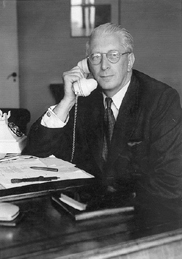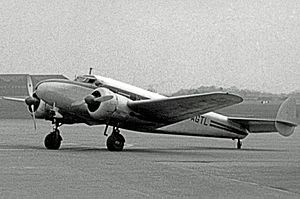Sidney Cotton facts for kids
Quick facts for kids
Sidney Cotton
|
|
|---|---|

Frederick Sidney Cotton c. 1941
|
|
| Born | 17 June 1894 Goorganga, near Proserpine, Queensland, Australia |
| Died | 13 February 1969 (aged 74) Uckfield, Sussex, England |
| Allegiance | Australia |
| Service/ |
|
| Years of service | 1915–1917 1939–1940 |
| Rank | Squadron Leader |
| Unit | P.D.U. (Photographic Development Unit) Royal Air Force |
| Commands held | P.D.U. (Photographic Development Unit) Royal Air Force |
| Battles/wars | First World War Second World War |
| Awards | Officer of the Order of the British Empire |
Frederick Sidney Cotton (born June 17, 1894 – died February 13, 1969) was an amazing Australian inventor, photographer, and flying expert. He helped create early color film and was super important in developing how we use cameras from planes to gather information, especially before and during World War II. He was even friends with famous people like Winston Churchill!
Contents
Early Life and Education
Sidney Cotton was born on June 17, 1894, on a cattle farm in Queensland, Australia. He was the third child of Alfred and Annie Cotton, who worked with farm animals. Sidney went to school in Queensland and later in England. In 1912, his family moved back to Australia. Before the war started, he worked as a "jackeroo," learning to manage livestock on big farms.
First World War Adventures
In November 1915, Cotton went back to England to join the Royal Naval Air Service. He became a combat pilot after only five hours of flying by himself! He flew patrols over the English Channel. Sidney also took part in night bombing missions over France and Germany.
In 1917, he invented the "Sidcot" suit. This special flying suit kept pilots warm in their cold cockpits. The Royal Air Force used this suit for many years, even into the 1950s. Cotton continued flying, but he disagreed with his senior officers. He left the military in October 1917.
Life Between the Wars
After the war, Cotton got married in London in 1917. He later spent time in Tasmania before returning to England. He loved flying and tried to fly from England to South Africa in 1920, but it didn't work out. He also survived a plane crash during a race called the Aerial Derby.
For three years, Cotton worked in Newfoundland, flying for different jobs. He helped spot seals from the air. He also flew search and rescue missions for explorers who got lost in Newfoundland and Greenland.
Secret Spy Missions
Before World War II, Sidney Cotton was asked to take secret aerial photos of Germany. He pretended to be a rich pilot or a film producer looking for places to film. He used a special civilian plane, a Lockheed 12A. This plane had three cameras hidden behind panels. He could slide the panels open and take pictures by pressing a button.
He even took his secretary, Patricia Martin, along, and she helped take photos too. Even though the German government told him where to fly, he often flew off course. He would secretly take pictures of military bases. Cotton was very good at convincing people and used every chance he got.
In 1939, he took photos over the Middle East and North Africa. Once, he even tricked a German air force officer into giving him a "joy-ride" over German airfields. While the officer was flying, Cotton secretly took pictures of the airfield. He even offered to fly a top German official to London just before the war started! People later called one book about him Sidney Cotton: The Last Plane Out of Berlin.
Second World War Contributions
In September 1939, Cotton became a Squadron Leader. He was put in charge of a new unit called the RAF 1 Photographic Development Unit (PDU). This unit gathered important information that helped the Royal Air Force plan successful attacks. Cotton used his experience to make the RAF's photo-taking from planes much better.
The PDU first used slow planes, but Cotton got faster ones like Spitfires and Mosquitos. These planes were made to fly higher and faster. They had a special shiny blue paint, called "PRU Blue," that Cotton himself helped create. This paint helped them blend in with the sky.
Under Cotton's leadership, his unit was nicknamed "Cotton's Club." He was known for being a bit unusual and not always following all the rules. He even had a special badge that said "CC-11," meaning the 11th commandment: "Thou shalt not be found out."
Cotton's aerial photos were very advanced for their time. He and his team developed ways to take high-altitude, high-speed 3D photos. These photos helped find the locations of important military targets. They even helped discover the secret sites for Germany's V-1 and V-2 rockets.
By mid-1940, Cotton had some disagreements with senior officials. He was removed from his role but was still given an award, the OBE. For the rest of the war, he worked as an unofficial advisor. His unit, now called the 1 Photographic Reconnaissance Unit (PRU), continued his innovative work.
In September 1940, Cotton's special Lockheed 12A plane was badly damaged in an air raid. It was rebuilt and later used in other countries. Another one of his planes, a Lockheed 12A (G-AGTL), is still in France today.
Cotton also had an idea for a searchlight on planes for night-fighters. He called it "Aerial Target Illumination." He worked with William Helmore, and they got patents for their ideas. This led to the development of something called Turbinlite.
After World War II
After the war, Cotton didn't have as much success in his private businesses. He didn't want to make money from his wartime inventions, like the Sidcot suit.
Around 1947, Cotton helped the state of Hyderabad resist joining India. He transported gold for Pakistan, which was an ally of Hyderabad. He also flew weapons, supplies, and medicine. Later, he faced charges for transporting weapons without permission. He was fined £200.
In 1951, Cotton married his third wife, Thelma "Bunty" Brooke-Smith. They had a son and a daughter.
There were false reports of Cotton's death in 1955. A magazine had to correct the story, saying he was "very much alive."
Cotton later worked in oil exploration and civil engineering. He also worked with a writer on a book about his life called Aviator Extraordinary: the Sidney Cotton story.
Sidney Cotton passed away on February 13, 1969, at the age of 74. He was remembered with the Sidney Cotton Bridge in Queensland, Australia.
Images for kids



